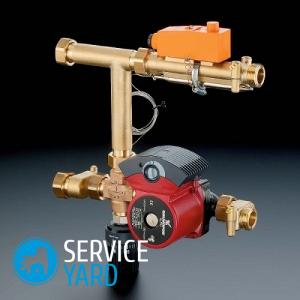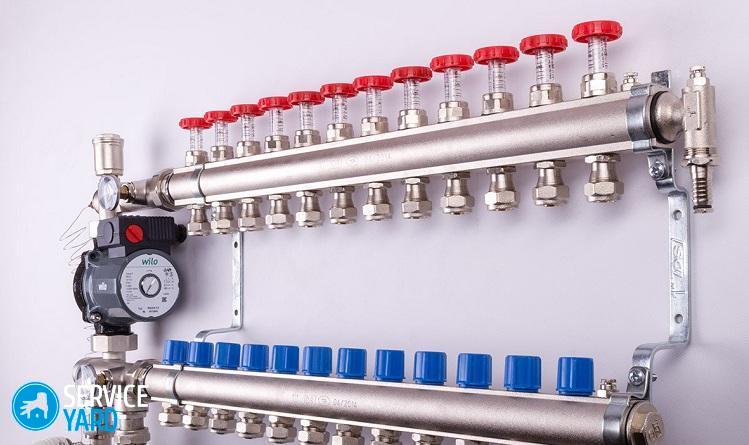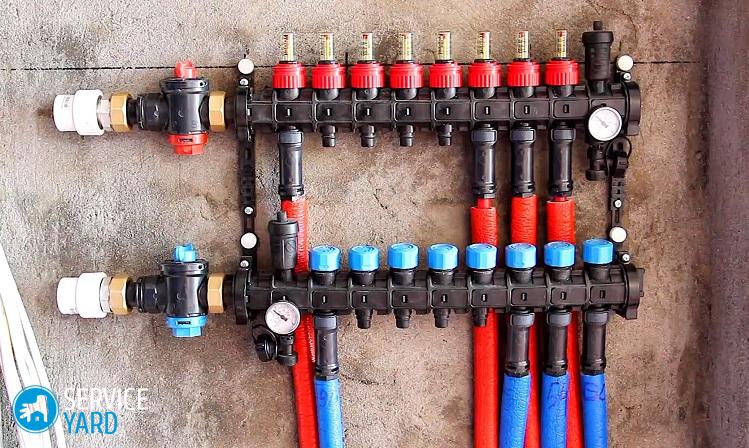How to assemble a collector for a warm floor?

The system of warm water floors can be considered a good alternative to conventional radiator heating or as an addition to it. It can be calculated both for the entire building, and for a separate room. In any case, it will be an autonomous system, which requires a certain preparation of the coolant that enters the heating circuit. It is these roles that the collector performs for warm water floors. This is a rather complex device that performs several functions at once. How it works and how to assemble a collector for a warm floor - let's understand.
to contents ↑The role of the collector with underfloor heating system
The collector is an element that floor heating cannot do without. All pipelines from heating circuits are connected to it. Since the temperature of the coolant that is transferred to the network from the boiler room is very high for the underfloor heating to work, the mixing unit must always work together with the collector. It provides a water temperature in the range of 40-45 degrees.
to contents ↑Important! Manifolds and mixing units for the warm floor perform the task of preparing the heat carrier at the right temperature and supplying it to all circuits.
System device
To understand how to assemble a collector for a warm floor, let's look at the collector device in more detail. It consists of two horizontal tubes that are connected to the supply and return lines.
Parts and housing of the collector are made of the following materials:
- Plastic.
- Stainless steel.
- Brass.
As a rule, the collector circuit of a warm floor is supplied by the manufacturer as follows:
- On the supply tube there are branches with thermostatic valves, on the return there are branches with flow sensors. On the thermostats there are plastic caps on top for manual adjustment - twisting them leads to pressing on the stem and blocking the flow. Flow sensors or flow meters, which are installed on the return pipe of the collector for warm water floors, are used to monitor the amount of flowing water, as well as perform hydraulic balancing of the system.
Important! In the cheapest models, collectors of flow sensors may not be.
- To control temperature and pressure, a thermometer with a manometer is installed on the collector, and a special valve is used to release air.
- The kit usually also includes plugs, taps, bends and staples for attaching the unit to the metal rails of the cabinet or walls.
to contents ↑Important! Some suppliers practice a complete set of the entire unit where there is a distribution manifold assembly with a two- or three-way valve and pump.
Operating principle
After installing the collector for a warm floor, the operation of the unit is as follows:
- The coolant runs along all floor heating circuits, prompted by the pump.
- In each circuit, the flow is controlled by a valve or valve manually or automatically from a servo or capillary.
- When the temperature in the return or supply pipe (depending on the circuit) drops below the set value, a two-way or three-way valve begins to mix hot water from the system, and the coolant flows from the processing into a common network.
to contents ↑Important! There are several schemes of operation of the mixing unit, in which various parts are used, however, its task remains the same: to maintain the desired temperature in the system of floor floors, as well as to control the flow of coolant in the supply branches.
Two way elements
These devices are sometimes called feed valves. Their main difference from standard valves is the ability to pass fluid in only one direction. In the case of a reverse - erroneous installation, such a valve will not work correctly and will quickly break.
Locking element
The role of the locking element for it can be performed by a ball or rod of a special design. So, adjustment is made either by turning the ball around its axis, or by moving the rod. In order to carry out such movements, electric or pneumatic drives are used that are connected to the sensors.
Thermostatic head
The most common option is the thermostatic head, which is equipped with a liquid sensor. It constantly monitors the temperature of the incoming coolant in the heating circuit. Depending on its performance, the head opens or closes the valve, as a result of which the supply of the heated coolant, which moves from the heater, resumes or stops.
Important! Thus, the liquid from the return is constantly supplied, and from the boiler - only as necessary. Its quantity is regulated using a two-way valve.
System advantages
The principle of operation of the device explains the main advantage of a manifold equipped with a feed valve:
- Warm floors with such a collector never overheat, which extends their service life.
- The low throughput of the two-way valve determines a smoother adjustment of the temperature of the coolant - sudden jumps are simply not possible here.
- The supply valves are easy to install and maintain, as well as reliable.
- Often they are included in the collector circuit, but have limitations in use.
to contents ↑Important! Installing two-way valves is not recommended in room systems with an area exceeding 200 sq m.
Three way devices
The three-way element is set differently. It combines the functions of a bypass feed valve and a balancing bypass crane:
- The element is a housing with two inlets and one outlet.
- To adjust, use either a vertically moving rod or a ball rotating around an axis.
Important! A feature of the three-way valve is that the control element does not completely overlap, but redistributes the incoming liquid, thereby mixing it.
- The temperature is regulated automatically, for which the valve is equipped with a drive system that reads information from various sensors.
Servos
Often, three-way devices are equipped with servo drives that control thermostatic elements or weather-dependent controllers. The servo drive is designed to actuate the locking element, which is mounted in the required position to obtain the desired ratio of the amount of hot coolant and return.
Important! Weather-sensitive sensors are needed to change the power of the underfloor heating system depending on the weather. For example, with a sharp cooling, the room will cool much faster, respectively - it will be more difficult for the heating system to cope with its work.
In order to facilitate her task, it is necessary to increase the flow rate of the coolant, as well as its temperature.
Cons of the system:
- The disadvantages of three-way valves include their throughput. Under such conditions, even a slight bias in the regulation of the valve will lead to a strong change in the temperature of the coolant in the circuit.
- Another disadvantage is the possibility of sharp jumps in the temperature of the coolant. It is very possible that the valve, which is triggered by a signal from the thermostat, will let coolant into the system of underfloor heating, which is heated to 95 degrees. Such jumps for the heating circuit are unacceptable - it may not withstand such pressure and burst.
to contents ↑Important! Three-way valves are used for collectors that are installed in rooms whose area exceeds 200 square meters. m and for systems with many circuits. In addition, they are indispensable for structures that are equipped with weather-dependent controllers that determine the necessary floor temperature taking into account external conditions.
Location of collector departments
For the underfloor heating system, one large collector can be mounted or an individual device can be installed in front of each heating circuit. In this case, each collector should be equipped with a flow meter, temperature controllers and three main elements:
- A radiator balancing shutoff valve that connects the collector to the heating system. It opens and closes the water supply to the circuit.
- A mixing valve that determines the degree of heating of the coolant in the heating circuit.
- An overflow valve, which is responsible for the constant pressure inside the pipes, which sends the excess coolant to the bypass.
The schemes for installing the collector for a warm floor can be different:
- For a system with a single radiator pipe, for example, a bypass is mandatory. Moreover, it should always be open - so an excess of hot coolant can be discharged directly into the radiator.
- If there is a return loop, then a bypass is optional.
- In the event that the heated area is not large, then the collector compartment can be placed in the secondary circuit.
Collector location
At the stage of design work, it is necessary to determine the place where the collector group will be mounted:
- Most often, it is installed in a special cabinet, which should have the necessary size to accommodate all the elements.
- The equipment is installed at a certain height from the floor near the main pipes.
- The cabinet should be placed in such a way that there is free space for bending pipes suitable to the collector.
- It is desirable that it be placed at the same distance from all heating circuits.
- If desired, the cabinet can be mounted in a special niche or simply attached to the wall.
Installation recommendations
Assembling a collector for a warm floor is quite simple. However, before starting work, you must carefully read the instructions that the manufacturer always puts into the packaging of equipment. Each of the operations must be carried out strictly in accordance with its recommendations.
In general, the assembly of the collector for a warm floor is as follows:
- Remove the tubes that are intended for the supply and return coolant from the packaging. They should already be equipped with valves and flow sensors. If the collector is divided into sections, then you should twist them together.
- Fasten the assembled pipes to the standard brackets, which will make it possible to work further with great convenience. Now the distributor should be a single unit.
- Replace the shutoff valves, control devices, connectors and plugs.
- Fix the manifold to the wall. Sometimes you can find recommendations where it is proposed to first install a valve and a circulation pump. However, in this case it will be inconvenient in the future to mount the assembled assembly.
- Install, in accordance with the diagram, a circulation pump with a thermal head and a servo drive.
- Connect the pipes to the assembly that come from the boiler. To the bends, attach pipes from the contours of the heated floors.
Important! All commissioning must be carried out before the concrete screed is poured. This is necessary in order to verify the tightness of all joints made. Make collector settings.
Check the operation of all control devices that allow you to configure the required heating mode for underfloor heating, as well as adjust the flow of coolant in each circuit.
to contents ↑DIY collector
Equipment that was manufactured in the factory is characterized by a rather high cost. Therefore, some experts decide to assemble a collector for a warm floor on their own. True, making it completely will not work. Some elements - shutoff valves, circulation pump and mixing valve, you still have to buy.
The easiest way to self-assemble the collector is to solder it with polypropylene pipes and fittings.
For work you will need:
- PPR pipe sections of the required diameter, as a rule, it is 25 or 32 mm, as well as tees and bends of the same size.
- Gates
- The number of fittings and taps will depend on the number of heating circuits.
- Scissors, tape measure.
- Special soldering iron for polypropylene parts with different nozzles.
Operating procedure:
- Mark up the future collector first. To do this, measure and cut pipe fragments, and do this in such a way that the distance between the tees is as small as possible. Otherwise, the part will be large and unaesthetic.
- Next, weld the transitions and taps to the tees.
- Connect the remaining fittings to the finished manifold, with which it will be connected to the pump.
Cons of a homemade collector
It must be understood that a collector assembled in this way will have a number of disadvantages:
- There will be no thermostatic valve on the supply pipe, and a flow sensor on the return. As a result, the system will need to be manually adjusted, which is inefficient and not very convenient.
- Of course, all these elements can be bought and installed in the collector. However, the cost of the product will become comparable with the finished plastic equipment, which makes its independent manufacture devoid of meaning.
Important! Practice shows that you can assemble a collector for a warm floor with your own hands. But it is advisable to do this only for the simplest models. Sophisticated equipment is best purchased ready-made.
- Another caveat is that homemade collectors usually have many joints. No matter how hard the specialist tried to make them extremely high quality, the specifics of this device are such that they will certainly let it flow. Regular repairs to a homemade collector will significantly reduce its life. Therefore, you should think carefully before deciding to make equipment yourself.
Stock footage
Installing a collector for a warm floor is a very responsible process. Such works require special knowledge and certain skills. You can conduct them yourself, however, the risk of mistakes is quite large. If you do not have confidence in your abilities, then it is better to contact qualified specialists.
- How to choose a vacuum cleaner taking into account the characteristics of the house and coatings?
- What to look for when choosing a water delivery
- How to quickly create comfort at home - tips for housewives
- How to choose the perfect TV - useful tips
- What to look for when choosing blinds
- What should be running shoes?
- What useful things can you buy in a hardware store
- Iphone 11 pro max review
- Than iPhone is better than Android smartphones





